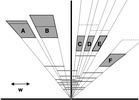








Watching a long unedited video is usually a boring experience. In this paper we examine a particular subset of videos, tour videos, in which the video is captured by walking about with a running camera with the goal of conveying the essence of some place. We present a system that makes the process of sharing and watching a long tour video easier, less boring, and more informative. To achieve this, we augment the tour video with a map-based storyboard, where the tour path is reconstructed, and coherent shots at different locations are directly visualized on the map. This allows the viewer to navigate the video in the joint location-time space. To create such a storyboard we employ an automatic pre-processing component to parse the video into coherent shots, and an authoring tool to enable the user to tie the shots with landmarks on the map. The browser-based viewing tool allows users to navigate the video in a variety of creative modes with a rich set of controls, giving each viewer a unique, personal viewing experience. Informal evaluation shows that our approach works well for tour videos compared with conventional media players.






Cellular phones are widely used to access the WWW. However, most available Web pages are designed for desktop PCs. Cellular phones only have small screens and poor interfaces, and thus, it is inconvenient to browse such large sized pages. In addition, cellular phone users browse Web pages in various situations, so that appropriate presentation styles for Web pages depend on users' situations. In this paper, we propose a novel Web browsing system for cellular phones that allocates various functions for Web browsing on each numerical key of a cellular phone. Users can browse Web pages comfortably, selecting appropriate functions according to their situations by pushing a single button.


The Web is a dynamic information environment. Web content changes regularly and people revisit Web pages frequently. But the tools used to access the Web, including browsers and search engines, do little to explicitly support these dynamics. In this paper we present DiffIE, a browser plug-in that makes content change explicit in a simple and lightweight manner. DiffIE caches the pages a person visits and highlights how those pages have changed when the person returns to them. We describe how we built a stable, reliable, and usable system, including how we created compact, privacy-preserving page representations to support fast difference detection. Via a longitudinal user study, we explore how DiffIE changed the way people dealt with changing content. We find that much of its benefit came not from exposing expected change, but rather from drawing attention to unexpected change and helping people build a richer understanding of the Web content they frequent.